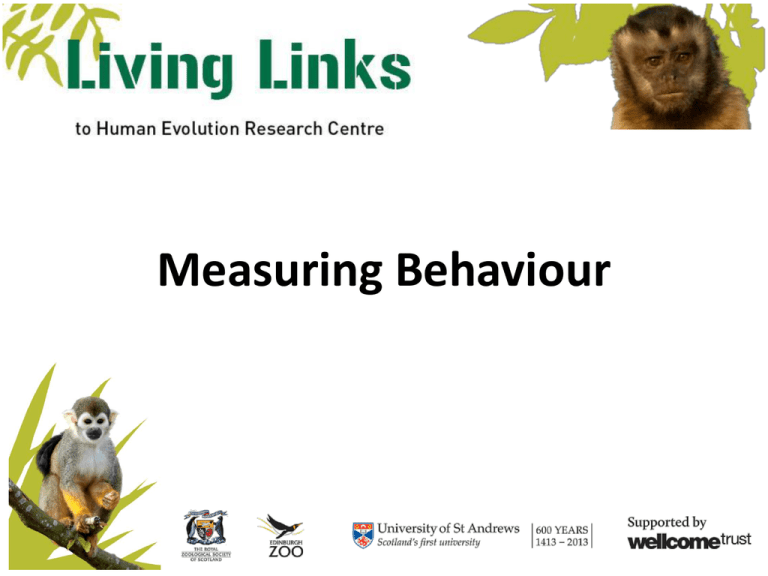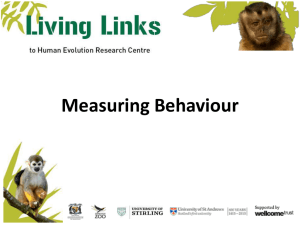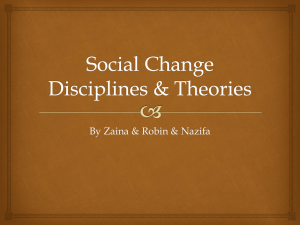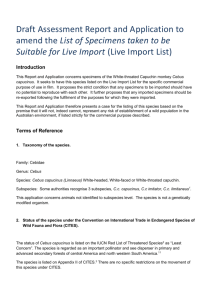
Measuring Behaviour
Learning Outcomes
Background
• Define animal behaviour and discuss what causes it.
• Understand why we study animal behaviour.
Measuring Behaviour
• Understand how we study animal behaviour (experimental design).
• Create an ethogram of primate behaviours.
• Create an activity budget from a video of capuchin monkey behaviour.
• Understand the concepts of latency, frequency and duration.
• Use various techniques to record primate behaviour (scan/focal).
Student Activity
What is Animal Behaviour?
Animal behaviour - Is simply what the animal is
doing, or how they are reacting.
Ethology – Is the study of animal behaviour.
‘Ethos’ – character
‘ology’ – the study of
What causes animal behaviour?
• To some extent all behaviours are genetic
(i.e. a monkey will act like a monkey, and a bird a bird)
• It is also a response to external/internal
environments.
• External environment – e.g. rain, heat, cold, etc.
• Internal environment – e.g. hormones,
disease, parasites.
External Environment
Factor/Stimuli
Behaviour response
Cold
Huddle together
Rain
Seek shelter
Internal Environment
Factor/Stimuli
Behaviour response
Hormones
Seek a mate
Disease
Rest
Why Study Animal Behaviour?
• Understand why animals behave
the way they do.
• Understand when an animal has a
need.
• Use this information to make
changes for the animals’ welfare.
How to Study Behaviour
1.
2.
3.
4.
5.
6.
7.
8.
9.
Formulate initial questions and make
preliminary observations.
Formulate hypotheses and make predictions.
Choose behavioural measures and research
design (methods).
Define each measure
Select the appropriate recording methods.
Practice the recording methods
Collect the data
Analyse the data
Draw some conclusions and return to step 1.
Studying a Mixed Species Exhibit
Capuchin Monkeys
Squirrel Monkeys
Taxonomy
Animalia, Chordata, Mammalia,
Primate, Cebidae
Cebus apella or Sapajus apella
Animalia, Chordata, Mammalia, Primate,
Cebidae
Saimiri sciureus
Size
1.3 – 4.8 kg, with males being larger
than females.
0.55- 1.25kg, males and females similar in
weight.
South American forests
South American forests
Mainly fruits and invertebrates, but
also eat small animals and plants.
Mainly insects and fruits but also eat
other parts of plants, and various small
animals.
Habitat &
Range
Diet
Capuchin Monkeys
Squirrel Monkeys
Social Structure
Group size ranges from 6-30. One
alpha male and female and a variety
of dominant-submissive interactions
throughout the rest of the group. No
linear hierarchy exists.
Group size 30-70. There are more adult
females in a group than adult males. There
is an alpha male and female and a variety
of dominant-submissive interactions
throughout the rest of the group. No linear
hierarchy exists.
Ecological Niche
Forest living insectivore-frugivores
that are arboreal and diurnal.
They are also prey for wild cats, such
as jaguars, birds of prey and
crocodiles.
Forest living insectivore-frugivores that are
arboreal and diurnal.
They are also prey for wild cats, such as
jaguars, birds of prey and crocodiles.
Communication
Capuchin monkeys have a wide range
of vocalisations, but they also
communicate with a variety of visual
signals and social behaviours.
Squirrel monkeys scream and give high
pitched ‘peep’ and ‘twitter’ calls, they also
communicate with visual signals and social
behaviours.
Capuchin Communication - http://www.living-links.org/wp-
Squirrel Monkey Communication – http://www.living-links.org/wpcontent/uploads/2012/05/SaimiriSIGNteachers.pdf
content/uploads/2012/05/CebusSIGNteachers.pdf
1. Formulate initial questions and make
preliminary observations
• How do the primates react to living in a mixed
species group?
• How does living in a mixed group effect their
behaviour and welfare?
• Do they interact in a positive, negative or
neutral way?
• When and where should I study the primates?
• How many primates can I study?
Study Site
Study Subjects
WEST
EAST
Capuchins
Sq. monkeys
Capuchins
Sq. monkeys
3 adult
females
2 young males
1 male infant
1 infant sex
unknown
1 adult male
3 young males
7 adult females
1 young female
3 male infants
1 alpha male
3 younger
males
1 adult female
1 alpha male
6 adult females
2 male infants
1 female infant
Total = 7
Total = 15
Total = 5
Total = 10
3.3.1
7.7.0
4.1.0
3.7.0
2. Formulate Hypotheses
1. Squirrel monkeys will be the initiators of
interactions, however the capuchins will
be dominant over the squirrel monkeys.
2. A change in the enclosure design will
have a positive effect on the relationship
between the two species.
3. Choose behavioural measures and
research design (methods)
Hypothesis 1 - Squirrel monkeys will be
the initiators of interactions, however the
capuchins will be dominant over the
squirrel monkeys.
Behavioural measure
Record species interactions, and the
direction of the interactions.
3. Choose behavioural measures and
research design (methods)
Hypothesis 2 - A change in the enclosure
design will have a positive effect on the
relationship between the two species.
Behavioural measure
Record species interactions before and
after the change.
4. Define each measure
(Ethogram and other Variables)
Say what you see, not what you think !
Behaviour
Definition
Aggression
Chasing, biting, hitting or screaming at another monkey. May include
threat displays, such as shaking branches or lunging at another.
Play
One monkey chases or wrestles with another, in a non-aggressive
manner.
Resting alone
Lying or sitting away from the group
Resting together
Lying or sitting in contact with another monkey
Feeding
Searching for/manipulating/ingesting food
Moving alone
Locomoting across the ground or in the trees
without another monkey.
Moving together
Locomoting across the ground or in the trees
with another monkey.
Design an Ethogram
SCREEN SHOT ONLY
Living Links website - http://www.living-links.org/resources/materialsfor-teachers/measuring-behaviour-lesson-plan/
Vimeo - http://vimeo.com/channels/livinglinks/45906210
5. Select the appropriate
recording methods
Focal
Observing one individual for a specified
amount of time and recording several
different categories of behaviour.
Scan
A group of individuals is scanned at regular
intervals and the behaviour of each one is
recorded.
Let’s Try a Focal
SCREEN SHOT ONLY
Living Links website - http://www.living-links.org/resources/materials-forteachers/measuring-behaviour-lesson-plan/
Vimeo - http://vimeo.com/13796260
Let’s Try a Scan
SCREEN SHOT ONLY
Living Links website - http://www.living-links.org/resources/materialsfor-teachers/measuring-behaviour-lesson-plan/
Vimeo - http://vimeo.com/45246079
5. Select the appropriate recording
methods
Adlibitum Sampling – No system,
observer just writes what is visible.
Continuous Sampling
All occurrences of behaviour are
recorded. When they start and
when they stop.
Point/Instantaneous Time Sampling
Behaviour is sampled periodically at
regular intervals.
Which recording methods were used in
Living together?
Focal
Continuous
Scan
Instantaneous
Adlib
Latency, frequency & duration
Latency – Is the time (sec, min,
hrs) from a specific event to the
start of a behaviour.
Frequency - the number of times
a behaviour is displayed per unit
of time.
Duration – The length of time
that a single behaviour lasts.
6. Practice the recording methods
Capuchin and chimpanzee videos
Extra challenge – Live Squirrel Monkey Cam
http://www.edinburghzoo.org.uk/monkeycam.html
or Live Snow Monkey Cam
http://www.highlandwildlifepark.org/snow-monkey-webcam
7. Collect the Data
Example Data sheet
EAST Wing Scan Sampling Check Sheet – 5 Capuchins (C) , 10 Squirrel Monkeys (S)
Time:
Date:
Weather:
Behaviour/
time
Aggression
Play
Resting
Alone
Resting
Together
Feeding
Start
II (C-S)
II (C-C)
II (S)
IIII (S)
I (C)
III (S)
1 min
2 min
3 min
4 min
5 min
Moving
Alone
Moving
Together
Other
Out of
View
I (C)
Using Your Ethogram
Type of
Interaction
Behaviour
Definition
Aggression
Chasing, biting, hitting or screaming at another monkey.
May include threat displays, such as shaking branches or
lunging at another.
_
Play
One monkey chases or wrestles with another, in a nonaggressive manner.
+
Resting alone
Lying or sitting away from the group
Feeding
Searching for/manipulating/ingesting food
Moving alone
Locomoting across the ground or in the trees
without another monkey.
N
+
N
N
Moving
together
Locomoting across the ground or in the trees
with another monkey in non-aggressive manner.
+
Resting together Lying or sitting in contact with another monkey
8. Analyse the data
Table - Frequency of directions of interactions between the two species
Direction
Negative
Positive
Neutral
Total
Capuchin to Squirrel
Monkey
14
10
13
37
Squirrel monkey to
capuchin
13
4
4
21
Enclosure Change Analysis
7&8. Collect and Analyse the data
• Collect data and create a simple activity
budget for the group of chimps.
or
• Collect the data and create a simple activity
budget for the capuchin Popeye.
or
• Collect the data and create a simple activity
budget from the create an ethogram video.
Activity Budget
Activity Budget – is a graph or table that shows
how much time an animal spends in various
activities such as, sleeping, eating, climbing etc.
eating
sleeping
moving
playing
9. Draw conclusions
• Hypothesis 1 - Squirrel monkeys will be the
initiators of interactions, however the
capuchins will be dominant over the squirrel
monkeys.
• Incorrect – Capuchins were more likely to
initiate interactions.
• Correct - Capuchins did appear to be the
dominant of the two species (in most cases)
Conclusions
• Hypothesis 2 - A change in the enclosure
design will have a positive effect on the
relationship between the two species.
• Correct – The frequency of interaction
between the species stayed the same however
the proportion of positive interactions
increased and negative ones decreased.
Anthropomorphism
Anthropomorphism – Applying human
qualities (emotions or actions) to nonhuman animals or things.
Eg. The wind tried to strip
the cloak off the man
Why would anthropomorphism be bad in
an animal behaviour study?
Play/Content Face
Fear Grin
Happy Grin
Sad Face
The Living Together Project Scientist
SCREEN SHOT ONLY
Living Links website - http://www.living-links.org/resources/materialsfor-teachers/measuring-behaviour-lesson-plan/
Vimeo - http://vimeo.com/7862457
Acknowledgements
•
•
•
•
•
•
Dr. Mark Bowler
Prof Andy Whiten
Dr Hannah Buchanan-Smith
Wellcome Trust
Kenny Hurst
The Zoo keepers at Edinburgh Zoo
For more resources visit:
http://www.living-links.org/resources
and
http://www.educationscotland.gov.uk











